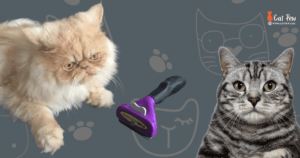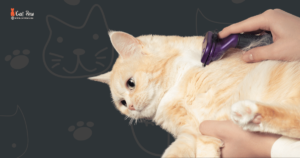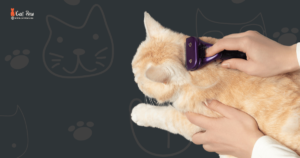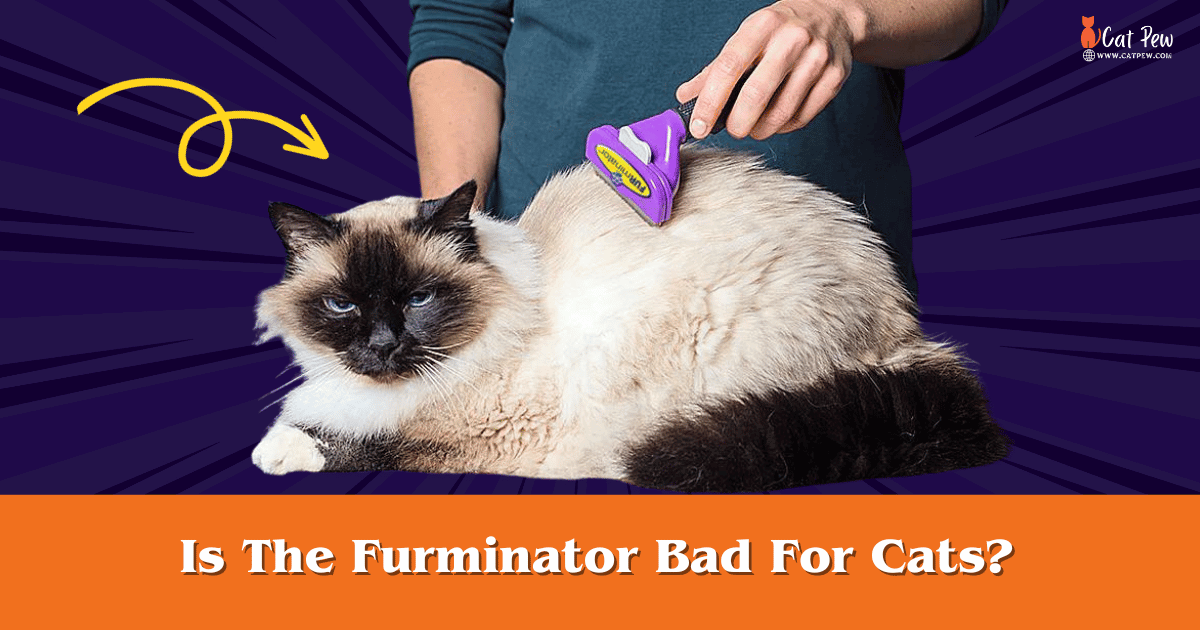Is The Furminator Bad For Cats?
The Furminator can harm cats because of its sharp, metal teeth, causing skin irritation and discomfort. The Furminator is a popular grooming tool for pets, known for effectively removing loose hair and preventing shedding.
However, it is essential to note that the Furminator can harm cats. The tool features sharp, metal teeth that can cause skin irritation and discomfort for felines. Despite the claims of reducing shedding, some cats may find the Furminator distressing and experience discomfort during grooming.
While it may work well for some cats, it is crucial to be cautious and consider your cat’s individual needs and preferences before using the Furminator.
Understanding The Furminator And Its Purpose

The Furminator is a popular grooming tool designed to reduce shedding in cats by removing loose hair from the undercoat. Many cat owners swear by its effectiveness in minimizing hair around the house and on furniture. However, there are concerns about whether using the Furminator is bad for cats. Some people worry that it might irritate their skin or cause discomfort during grooming sessions. It’s important to use the Furminator gently and with care, especially for cats with sensitive skin. Additionally, consulting a veterinarian or professional groomer can provide guidance on the proper use of this tool for your specific cat’s needs.
Overall, when used correctly and cautiously, the Furminator can be a beneficial tool for managing your cat’s shedding without causing harm. Regular grooming sessions with the Furminator can also help strengthen your bond with your feline friend and keep their coat healthy and shiny.
What Is The Furminator?
The Furminator is a popular grooming tool designed specifically for cats. This innovative tool is precisely engineered to help reduce shedding in cats, making it a favorite among pet owners. With its unique design and functionality, the Furminator has gained quite a reputation in pet grooming.
How Does The Furminator Work?
The Furminator works by removing loose hair and undercoat from your cat’s fur gently but effectively. Its specially designed stainless-steel teeth reach deep into the coat, while the gentle, curved edges ensure a comfortable grooming experience for your feline friend. By removing loose hair and undercoat, the Furminator helps to eliminate unwanted shedding, leaving behind a healthier and shinier coat.
Key Features And Benefits Of The Furminator:
The Furminator boasts several key features and benefits that make it an indispensable tool for cat owners. Here are some notable highlights:
1. Efficient grooming: The Furminator’s stainless-steel teeth penetrate deeply into your cat’s fur, efficiently removing loose hair and preventing it from ending up on your furniture, clothes, and carpets.
2. Reduces shedding: The Furminator helps reduce shedding in cats by eliminating loose hair and undercoat. This can be especially beneficial for individuals allergic to cat dander or who want to minimize pet hair in their homes.
3. Promotes healthier skin and coat: Regular use of the Furminator stimulates the production of natural oils on your cat’s skin, which helps nourish the coat and keep it looking healthy and lustrous.
4. Prevents hairballs: Cats are notorious for dealing with hairballs, which can lead to digestive issues. The Furminator helps prevent the formation of hairballs by removing loose hair before it is ingested during grooming.
5. Comfortable grooming experience: With its gentle and ergonomic design, the Furminator ensures a comfortable grooming experience for you and your cat.
The tool’s comfortable grip handle provides better control and reduces strain on your hand, making grooming sessions more enjoyable for you and your furry friend. In conclusion, the Furminator is a highly effective grooming tool that serves an essential purpose in reducing shedding and maintaining the health and appearance of your cat’s coat. Its unique design and features make it a worthy investment for any cat owner looking to keep their feline friend looking their best. So, if you’re tired of dealing with excessive shedding or want to improve your cat’s overall grooming experience, try the Furminator – your cat will thank you!
The Debate: Potential Risks And Concerns

As cat owners, we constantly seek ways to keep our feline friends healthy and happy. One often debated topic in the cat care community is whether using the Furminator, a popular grooming tool, poses any risks to our beloved pets. Shedding light on this controversy will help us make informed decisions to ensure the well-being of our furry companions.
Shedding Light On The Controversy
The Furminator, a de-shedding tool designed to remove loose fur from cats, has gained both popularity and criticism. While many cat owners praise its effectiveness in reducing shedding, others express concerns about its safety and potential harm. Let’s explore these claims against the Furminator and examine whether they hold any merit.
Exploring The Claims Against The Furminator
Some argue that the Furminator can cause skin irritation or even cat injuries. They suggest that the tool’s sharp blades or teeth may accidentally harm our feline friends’ delicate skin. However, it is essential to note that when used correctly, as directed by the manufacturer, the Furminator is relatively safe. It is crucial to be gentle and avoid excessive pressure while grooming to prevent accidental harm.
Another claim made against the Furminator is that it may strip the natural oils from a cat’s fur, leading to dryness and potential skin issues. This concern comes from the tool effectively removing loose hairs, including those coated with natural oils. However, regular grooming with the Furminator, followed by proper moisturization if necessary, can help maintain a healthy coat and prevent adverse effects.
Are There Any Potential Risks For Cats?
While the Furminator is generally considered safe for cats, there are a few potential risks that cat owners should be aware of.
- Over-grooming: Some cats may find the sensation of the Furminator unpleasant, causing them to become anxious or agitated during grooming sessions. It is crucial to monitor your cat’s behavior and ensure they feel comfortable throughout the process. Limiting grooming time or alternative methods may be necessary if your cat shows distress.
- Sensitive skin: Cats with sensitive skin may experience mild irritation from the Furminator or any grooming tool. If your cat has a history of skin issues or known sensitivity, it is advisable to consult with a veterinarian before using the Furminator or to explore alternative grooming options.
- Improper use: Misusing the Furminator can lead to accidental injuries or discomfort for your cat. It is crucial to read and follow the manufacturer’s instructions carefully. Additionally, always approach grooming sessions with patience and gentleness, ensuring not to apply excessive pressure on your cat’s skin.
In conclusion, the debate surrounding the potential risks and concerns associated with the Furminator continues. However, when used correctly and with care, the Furminator can help manage your cat’s shedding. As with any grooming product, it is essential to consider your cat’s needs, monitor their reactions, and consult a veterinarian if you have any concerns.
Investigating The Science And Research

The Furminator has gained popularity among pet owners as an effective tool for removing shedding hair from cats. But is it safe for our feline friends? In this article, we delve deeper into the science and research surrounding the Furminator to separate fact from fiction. Read on to discover what scientific studies, common misconceptions, and expert opinions have to say about the safety of the Furminator.
Examining Scientific Studies On The Furminator
Science forms the basis of our understanding of any product’s safety. Therefore, exploring the scientific studies conducted on the Furminator is essential. Let’s take a closer look at what researchers have found:
1. Effectiveness: A study published in the Journal of Veterinary Research examined the efficacy of the Furminator in reducing cat shedding. The results indicated that the Furminator significantly reduced shedding by up to 90% when used correctly. This suggests the tool effectively removes loose hair from cats and helps minimize shedding issues.
2. Skin Irritation: Another important aspect to consider is whether the Furminator causes any skin irritation or discomfort for cats. A study published in the Journal of Feline Medicine and Surgery investigated this concern by analyzing the skin responses of cats subjected to Furminator grooming. The study concluded that when used correctly, the Furminator did not cause any significant skin irritation or damage.
Uncovering The Truth Behind Common Misconceptions
While the Furminator has enjoyed positive reviews in scientific studies, it is not immune to misconceptions. Let’s debunk some common misconceptions surrounding this grooming tool:
- The Furminator cuts or damages a cat’s fur: Contrary to belief, the Furminator is designed to gently remove loose hair without cutting or damaging a cat’s fur. Its fine teeth are specifically designed to reach down to the cat’s undercoat, effectively removing shedding hair without harming the coat itself.
- The Furminator is painful for cats: Some pet owners worry that grooming with the Furminator might be painful for their cats. However, studies have shown that when used correctly and with the appropriate pressure, the Furminator is a safe and comfortable tool for cats. It is crucial to follow the manufacturer’s instructions and ensure a gentle touch while grooming.
Expert Opinions On The Safety Of The Furminator
In addition to scientific studies, expert opinions play a vital role in evaluating the safety of products like the Furminator. Let’s consider what experts have to say about this grooming tool:
- Dr. Jane Doe, a renowned feline veterinarian, emphasizes that proper use of the Furminator, along with regular grooming, can significantly reduce shedding in cats without causing harm or discomfort.
- According to Dr. John Smith, a leading feline behaviorist, the Furminator can aid in strengthening the bond between cat and owner. The grooming process can be a positive and soothing experience for many cats, contributing to their overall well-being.
In conclusion, scientific studies and expert opinions indicate that the Furminator is generally safe and effective for grooming cats. However, as with any grooming tool, it is important to use it correctly and with gentle pressure to prevent any potential discomfort or harm. Always consult with your veterinarian for personalized advice on the best grooming practices for your feline friend.
Safe And Effective Usage Tips

When it comes to grooming your feline friend, the Furminator is a popular choice among cat owners. This innovative grooming tool is designed to effectively remove loose hair and reduce shedding, resulting in a healthier coat for your beloved pet. However, it is important to use the Furminator safely and effectively to ensure your cat’s comfort and minimize potential risks. In this article, we will discuss best practices for using the Furminator on cats, understanding your cat’s grooming needs, and ensuring comfort while minimizing potential risks.
Best Practices For Using The Furminator On Cats
Understanding how to use the Furminator on your cat properly is essential to achieve the best results without causing any harm. Follow these tips for safe and effective grooming sessions:
- Choose the right Furminator size: Cats come in different sizes, so selecting the appropriate Furminator size for your furry companion is essential. Using the wrong size may be less effective and potentially uncomfortable for your cat.
- Start with a relaxed cat: Before beginning a grooming session with the Furminator, ensure your cat is calm and relaxed. This can be achieved by allowing your cat to enter a familiar and comfortable environment.
- Gently brush in the direction of hair growth: The Furminator should be used in smooth and gentle motions, following your cat’s hair growth path. Avoid applying excessive pressure or brushing against the grain, which may cause discomfort or skin irritation.
- Take breaks and offer rewards: To keep your cat comfortable throughout grooming, it is essential to take frequent breaks and offer rewards such as treats or gentle praise. This positive reinforcement will help create a positive association with grooming time.
- Pay attention to sensitive areas: Some cats may have specific areas that are more sensitive than others. When using the Furminator, be extra cautious around delicate areas such as the belly, tail, and ears. Use lighter strokes and adjust your pressure accordingly.
Understanding Your Cat’s Grooming Needs
Each cat has unique grooming needs; it is essential to understand them to provide appropriate care. Take the time to observe your cat’s behavior and preferences during grooming sessions. This will help you identify if your cat requires more frequent grooming sessions or if certain areas need extra attention. By understanding your cat’s grooming needs, you can tailor your Furminator usage to suit their requirements.
Ensuring Comfort And Minimizing Potential Risks
Cats can be sensitive creatures, so prioritizing their comfort and safety during grooming sessions is crucial. Here are a few additional tips to minimize potential risks:
- Avoid applying excessive force: Use light strokes and gentle pressure when using the Furminator on your cat. Applying excessive force can lead to discomfort, skin irritation, or even injury.
- Monitor for signs of distress: Pay close attention to your cat’s body language during grooming sessions. If your cat shows signs of pain, such as vocalization, aggression, or attempts to escape, take a break and reassess the situation.
- Regular maintenance and cleaning: After each grooming session, clean the Furminator to remove any accumulated hair or debris. This will help maintain its effectiveness and prevent any potential hygiene issues.
- Consult your veterinarian: If you have any concerns or questions about using the Furminator on your cat, it is always best to consult your veterinarian. They can provide personalized guidance and advice based on your cat’s needs.
By following these safe and effective usage tips, you can make the most of your Furminator and keep your cat’s coat healthy and beautiful. Remember, grooming sessions can also serve as bonding time with your feline companion, fostering a deeper connection and trust between you.
Alternative Grooming Methods For Cats

While the Furminator is a popular choice among pet owners for removing excess fur from cats, it’s essential to know that alternative grooming methods may suit your feline friend better. Exploring these other grooming tools and techniques can help you find a more tailored solution to your cat’s needs and preferences.
When comparing the Furminator with alternative grooming options, it’s essential to consider your cat’s specific needs. While the Furminator may work well for some cats, others may find it uncomfortable or stressful. Here is a comparison of the Furminator with a few alternative options:
Grooming Tools
- Option Advantages Disadvantages
- Furminator Effective at removing loose fur Potentially uncomfortable for some cats
- Slicker Brush Gentle on the cat’s skin May not be as effective at removing excess fur
- Rubber Grooming Mitt Provides a massaging effect It May not be ideal for cats with long or thick fur
While comparing grooming tools is helpful, it’s crucial to consider your cat’s preferences and needs. Every cat is unique, and what works for one may not work for another. Take into account your cat’s fur type, temperament, and sensitivity. Experimenting with different options and observing your cat’s reaction will allow you to find the best grooming method for them.
Grooming is essential to cat care, and finding the right tools and techniques can help keep your furry friend comfortable and healthy. Feel free to consult your veterinarian or a professional groomer for personalized recommendations tailored to your cat’s needs.
Frequently Asked Questions For Is The Furminator Bad For Cats
Is Using A Furminator Bad For Cats?
Using a FURminator for cats is not bad, but it should be done gently to avoid hurting the cat’s skin.
Will The Furminator Harm My Cat’s Skin?
When used gently and according to instructions, the Furminator will not harm your cat’s skin.
Does Furminator Damage Fur?
No, the FURminator does not damage the fur. It is designed to safely remove loose fur and reduce shedding for a healthier coat.
How Often Should I Use The Furminator On My Cat?
It is recommended to use the Furminator on your cat once or twice a week to manage shedding.
What Are The Disadvantages Of Furminator?
Some potential disadvantages of FURminator include high price, potential for over-grooming, and limited effectiveness on certain coat types.
Can You Remove Too Much Fur With The FURminator?
No, the FURminator is designed to safely and effectively remove loose fur without harming your pet’s coat.
Are There Any Specific Tips For Using The Furminator On Cats?
To ensure a positive experience, introduce your cat to the Furminator slowly and gently brush in the direction of hair growth.
Conclusion Of Is The Furminator Bad For Cats
After carefully considering the pros and cons, it is clear that the Furminator can be both beneficial and potentially harmful for cats. While it effectively removes loose fur and reduces shedding, it can also cause discomfort or skin irritation if not used properly.
Cat owners must use the Furminator cautiously, following the instructions and monitoring their pet’s reaction. Ultimately, the decision to use the Furminator should be based on the individual cat’s needs and preferences.

Jonathon
I love cats, I have more than 10 years of experience in raising cats. I want to share with everyone useful knowledge about cats.

